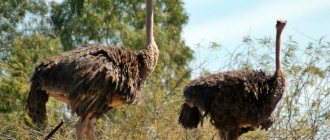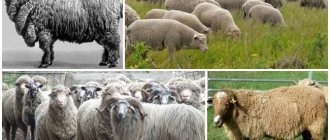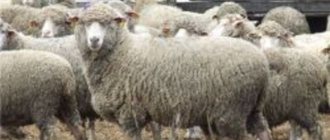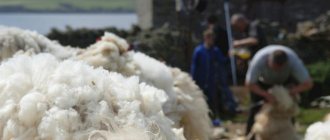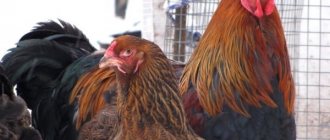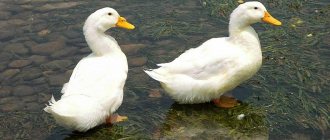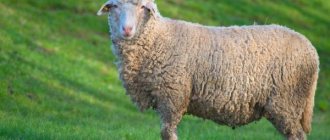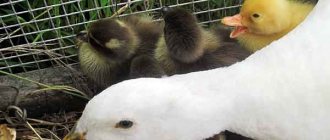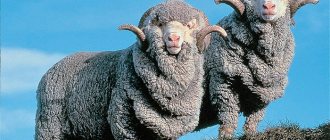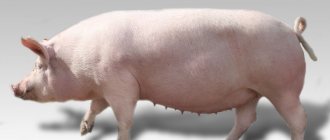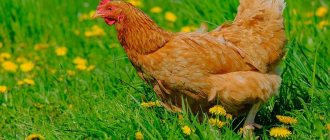Sheep and rams are among the first animals domesticated by humans. For thousands of years, they provided people with nourishing food and warm clothing. Even taking into account the development of intensive technologies, sheep breeding currently remains the basis of agriculture in many countries.
Therefore, sheep breeding as a business deserves close attention from beginning entrepreneurs. In Russia, raising these animals is as profitable as bulls or pigs: they can easily tolerate cold, do not require special feed, reproduce well and grow to marketable size in just ten months.
Why breed sheep?
Why should an entrepreneur learn how to become a sheep farmer? The fact is that these animals are extremely productive and provide the agricultural business owner with many sought-after products. Among them:
- Mutton. Delicious lean meat that is ideal for barbecue. Up to 55% of the product is obtained from the carcass, and the net yield without bones and veins reaches 35%;
- Wool. The shearing from ordinary breeds is 2–3 kg, and from fine-fleece – up to 9 kg. Rams are sheared twice a year, and Romanov sheep even three times;
- Skin. Animals produce 18–30 dm² of sheepskin, which is used for sewing warm clothes, shoes and hats;
- Milk. A productive sheep produces up to 150 liters of milk rich in vitamins and microelements, which is suitable for making cheeses, feta cheese and butter;
- Animal fat. Used in cooking and medicine. Lamb fat is used to treat bronchitis and arthritis. Carcasses of fat-tailed breeds contain up to 30 kg of product;
- Smushki. They are the skins of newborn lambs with fine wool and a characteristic hair curl. Due to their small size they are highly valued.
Business Features
There is a widespread belief among beginners that raising sheep at home is less profitable for novice entrepreneurs than keeping the same chickens. But experienced livestock breeders know that such a business has many advantages:
- Rams grow very quickly and gain marketable weight in just a year;
- Females of common breeds can give birth to lambs twice a year;
- Animals are not afraid of frost and feel good in an unheated room;
- To breed sheep from scratch you do not need expensive equipment;
- Animals have enough natural food supply;
- Large enterprises do not engage in sheep farming, so competition is low;
- When raising sheep, a farmer can count on government support.
It should be noted that certain shortcomings are still characteristic of sheep farming as a branch of agriculture. Here are the most relevant ones:
- Breeding animals of productive breeds cost several thousand rubles;
- Without rich, extensive pastures, raising sheep is unprofitable;
- Wool and sheepskin are not in high demand. The main profit comes from meat;
- Even a medium-sized herd cannot be maintained without hired workers;
- The farmer needs working capital, since profit can only be expected in a year.
Basic rules for caring for animals
Of course, in order to start breeding sheep at home, you need to at least become familiar with some of the features of their maintenance and feeding, and study their habits. Well, and of course, study the basics of veterinary medicine in order to be able to understand when something is wrong with an animal. Although, in fact, breeding and keeping sheep is not at all difficult if you adhere to the basic rules:
- Animals must undergo regular veterinarian examinations and mandatory vaccinations (according to the vaccination schedule). To avoid outbreaks of various diseases and mass mortality of animals, new individuals must undergo quarantine before joining the herd;
- When raising sheep at home, you need to remember that their hooves need to be cleaned and trimmed from time to time. This procedure will keep your leg joints healthy. In addition, to prevent the hooves from being subjected to sudden hypothermia during winter frosts, care must be taken to ensure that the floor in the sheepfold remains dry and relatively warm (it is made of boards and covered with straw);
- Constantly ensure that the sheep’s diet contains a sufficient amount of salt (it is added to food) and vitamins, which are abundant in pasture plants and young green shoots;
- The process of mating and reproduction of animals must be controlled by keeping breeder rams separate from the herd;
- To manage the herd, the pasture needs to be equipped with electric fencing, and also to acquire guard dogs that will keep an eye on the cattle and guide them through the pasture in the right direction.
By the way, considering the idea of raising cows as a business at home, such shepherd dogs and “electric fencing” could also be very useful. After all, then the herd will be under constant supervision even when the owner of the animals is busy with other things.
In addition to following the above rules, before starting to raise sheep at home, a novice breeder needs to draw up a detailed business plan for breeding sheep, which clearly outlines the scale of the business and all the costs of its implementation. In particular, you must indicate exactly how many animals will be in your flock (this figure will affect the parameters of the sheepfold and the required supply of feed). In addition, this will allow you to calculate how much it will cost:
- Arranging a place to store a supply of hay (you need to prepare enough of it, since, along with other components, this is the main food for sheep in winter);
- Organizing a place for the process of walking animals (lambs should spend most of their time in the fresh air, so they need to be provided with walking even in winter);
- Arrangement of a place for storing sheep waste products.
The cost of purchasing a veterinary first aid kit, which must include:
- Products for treating skin lesions (chemi-spray or aluminum-spray);
- Preparations to combat foot rot (for example, tar, kubatol);
- Agistamines;
- Timpanol;
- Large enema, syringes, gastric tube, bandages, cotton wool, tourniquet.
The fact is that when planning to raise sheep as a business, the future farmer must be prepared for the fact that animals sometimes have problems with rumen swelling. And you can remove gases from the stomach with the help of tympanol, which is injected into the suffering animal, or by using a gastric tube. If the ram is not helped in time, it may die.
Sheep breeds for breeding
A novice entrepreneur, as a rule, has a question: where to start raising sheep as a business? First of all, you need to decide on the priority direction of the farm’s activities, be it the production of meat, wool or hides. Next, you need to select breeds that are suitable for productivity:
- Rough-haired. They have a thick undercoat and thick hair. In the direction, fur-meat, smushkovye, meat-greasy and meat-wool-dairy breeds are distinguished;
- Semi-coarse-haired. They are distinguished by a large amount of fluff and transitional hair. They also have high meat and fat productivity;
- Fine-fleece. They are characterized by fine, uniform downy hair without guard hairs. There are wool, meat-wool and wool-meat breeds;
- Semi-fine fleece. They also do not have guard hairs, but there are many transitional fibers in the wool. They are divided into long-haired, short-haired and meat-haired breeds.
Currently, at least 60 breeds of sheep are bred in Russia. Here are brief characteristics of the most popular of them:
Characteristics of sheep breeds
| Name | Breed type | Weight, kg | Cut, kg | Fertility, % | |
| Male | Females | ||||
| Kuibyshevskaya | semi-fine wool meat-wool | 90–110 | 62–65 | 4–7 | 120–130 |
| Romanovskaya | rough-haired meat-haired | 90–120 | 45–50 | 3–4 | 130–180 |
| Edilbaevskaya | semi-coarse-haired meat-greasy | 110–160 | 65–100 | 4–5 | 110–120 |
| Gissarkaya | rough-haired meat-greasy | 130–200 | 75–80 | 1,5–1,7 | 110–120 |
| Texel | semi-fine-fleece meat | 85–150 | 60–120 | 4–6 | 130–220 |
| Merino | fine wool meat wool | 95–130 | 45–55 | 11–13 | 130–140 |
| Karakulskaya | rough-haired smushkovaya | 70–90 | 45–50 | 3–4 | 140–150 |
| Tsigeyskaya | semi-fine wool meat-wool | 85–110 | 45–60 | 6,5–8 | 120–150 |
| Stavropolskaya | fine wool wool | 100–110 | 50–65 | 14–19 | 120–135 |
Choosing a breed for a novice sheep farmer
Sheep breeding should begin with choosing a breed. With regard to the direction of productivity, they distinguish between wool, meat-wool and meat-wool-milk, and according to the type of fleece - fine-fleece, semi-fine-fleece, coarse-wool and semi-coarse-wool. All these criteria must be taken into account when selecting animals for breeding.
Beginners should choose one of the following breeds:
- Romanovskaya;
- Kuibyshevskaya;
- Karakul
Did you know? Sheep have a rectangular pupil. The pupil of an octopus has the same structure.
Romanovskaya
Main characteristics of the Romanov sheep breed:
| Direction | meat, wool and dairy |
| Appearance | the skull is light; hook-nosed profile; ears are erect, mobile; the hooves are strong, the legs are straight; there are no fat deposits on the body; the tail is short, up to 10 cm; the constitution is strong and rough; coat color is grayish-blue; all individuals are polled (hornless). |
| Weight, kg) | |
| female | 50–55 |
| male | 60–80 |
| young | 2–4 |
| Performance | |
| wool (kg) | 1,5–3 |
| milk (l) | 30–50 |
| meat (slaughter yield, %) | 50 |
| queen fertility (%) | 130 |
| Gain per month (kg) | 6-7 |
| Advantages | polled; high performance in all directions; precociousness; good adaptation abilities. |
| Flaws | timidity, especially during long-term grazing. |
Kuibyshevskaya
Main characteristics of the Kuibyshev sheep breed:
| Direction | meat and wool |
| Appearance | the head is wide; the constitution is powerful; legs are straight and strong; the hooves are strong; The coat color is silver-gray or sand-brown, all individuals are polled. |
| Weight, kg) | |
| female | 46–60 |
| male | 70–95 |
| young | 3–5,5 |
| Performance | |
| wool (kg) | 8–10 |
| milk (l) | 20–30 |
| meat (slaughter yield, %) | 60 |
| queen fertility (%) | 130 |
| Gain per month (kg) | 6–8 |
| Advantages | polled; precociousness; high performance; excellent wool quality; marbled meat. |
| Flaws | fluctuations in coat thickness in non-breeding individuals; not suitable for breeding on unproductive pastures and in arid climates. |
Karakulskaya
Main characteristics of the Karakul sheep breed:
| Direction | meat, wool and dairy |
| Appearance | hook-nosed profile; head of medium size, elongated; males have large, spiral-twisted horns, females have slightly smaller ones; legs are thin, strong; The constitution is neat. |
| Weight, kg) | |
| female | 40–50 |
| male | 60–70 |
| young | 3–5,5 |
| Performance | |
| wool (kg) | 2,6–3 |
| milk (l) | 30–50 |
| meat (slaughter yield, %) | 47–56 |
| queen fertility (%) | 120–130 |
| Gain per month (kg) | 6,5–7,5 |
| Advantages | precocity; high performance; high levels of immunity; good adaptability to cold climates; ease of care; purebred breed. |
| Flaws | do not tolerate hot climates well. |
How to buy rams for breeding?
To purchase livestock and young animals, you must contact breeding farms that carry out selection work and guarantee the purity of the breed. It is better to purchase rams and ewes from different places to prevent inbreeding. It is undesirable to cooperate with small private owners: on such farms, usually no one is focused on increasing productivity, as a result of which the likelihood of receiving defective animals is quite high.
When choosing individuals for breeding and keeping sheep at home, you need to pay attention to their exterior and constitution:
- The ram should have a wide and deep chest, a tucked belly, strong, correctly positioned legs;
- The back should be straight. If it is sagging or slanted back, the ram is probably not in good health;
- Wool breeds must have strong bones, elastic skin, and thick undercoat. For such animals, muscle mass and fat content are less important;
- In fine-wool breeds, the length of the coat should exceed 7–8 cm. Too thin hair indicates a weak constitution of the animal;
- For meat-and-haired breeds, large size, muscle volume, strong physique, and the presence of fat on the belly and sides are important.
By analyzing the offers of farms engaged in breeding purebred sheep for breeding, one can get an idea of the average prices for animals:
- Four-month-old lambs are sold for an average of 2,500–3,000 rubles per head;
- Yarka and sheep of meat-and-wool breeds cost about 8,000–12,000 rubles;
- An adult breeding ram is estimated at approximately 10,000–15,000 rubles;
- Sheep and lambs are sometimes sold live for 150–200 rubles per kilogram.
Diseases and injuries
If sheep are kept in good conditions and fed properly, they usually do not have health problems. As for injuries, to eliminate them it is necessary to select flat areas for grazing.
If improper care is taken, infection may occur:
- obesity - corrected by changing the diet, eliminating combined feeds;
- rhinitis, tracheitis, bronchitis - treated with antibiotics, vitamins (prescribed by a doctor);
- problems with the intestines - are solved depending on the cause (there can be many of them).
Ways to keep sheep
There are four ways to breed and keep sheep. To choose the right one among them, you need to take into account the climatic features of a particular area and the level of availability of natural food resources:
- Stall. Distributed in regions of active farming, where the land is mainly occupied by fodder crops and there are no free pastures. In winter, animals are kept mainly indoors, and in summer - in pens;
- Stall-pasture. Used in regions where there is a developed food supply and no winter pastures. In summer, animals are kept on grazing almost all the time, and with the onset of cold weather they move to premises with walking areas;
- Pasture-stall. It is used for home breeding of sheep in areas where there is the possibility of grazing in early spring and late autumn. Animals are moved to free-range stalls only in very cold weather;
- Pasture. It is practiced in warm regions where there are not only summer but also winter pastures. Animals are grazed all year round, however, during the cold season they are additionally fed with concentrates.
How to care for sheep?
To effectively use the natural food supply in the summer, the herd is constantly kept on pastures, driving the rams into stalls only at night. This method of keeping determines the list of measures for caring for livestock:
- Animals begin to graze when the daytime temperature in spring is set at 5–8°C, and at least five-centimeter grass grows in the meadows;
- The flock is driven out to pasture early in the morning. At lunchtime, the rams rest in shaded areas near watering holes. Grazing ends before dusk;
- The veterinarian examines the animals monthly, identifying weak or pregnant animals. In order not to catch sheep in the meadow, you can do this near the feeders;
- In rainy weather, the rams are fed under a canopy. Wet wool takes a very long time to dry, and therefore animals can catch a cold;
- Blood-sucking insects cause trouble for the herd. The rams are regularly checked, parasites are removed and wounds are disinfected.
During the cold season, animals spend the night in a warm sheepfold. But if the weather permits, during the day the animals are taken out to the walking area. Staying in the fresh air improves the health of rams, improves their appetite and improves the quality of wool. What else needs to be done in autumn and winter:
- In preparation for wintering, they stock up on hay and vegetable feed, clean and disinfect the sheepfold premises;
- A month before transfer to the stalls, all veterinary procedures are carried out - animals are vaccinated, they are given drugs against worms and scabies;
- Before the rams are released, the floors in the sheepfold are covered with straw bedding. Every day after manure removal, new portions of bedding material are added;
- Feed troughs and drinking bowls are cleaned daily. On cold days, it is advisable to warm fresh water to room temperature;
- Every 3–4 months, animals have their hooves trimmed and cleaned, removing horny tissue. In winter, due to lack of movement, hooves grow especially quickly;
- For rams of fine-wool breeds, the hair around the eyes that bothers the animals is cut off as necessary.
What to feed the sheep?
The composition of sheep feed also varies depending on the time of year. For such large animals, its energy and nutritional value should be high:
- In summer, the basis of the diet is fresh grass. If you provide the animals with good pasture, you can do without feeding. But it is better to add vegetables and grains to the food;
- In autumn, the grass becomes less nutritious, so the sheep are additionally given silage, root crops, tops, grains and combined feed;
- In winter, green grass is replaced with meadow hay and straw. In addition to root vegetables and grains, vitamin premixes are added to the diet;
- In the spring, when the first fresh grass appears, the animals begin to be turned out to pasture, supplemented with feed and hay.
In winter, raising sheep at home for beginning farmers is complicated by the need to provide the animals with adequate nutrition. To meet the need for vitamins and nutrients they need:
- Hay of legumes and meadow grasses. You should not give rams sedge, reeds, feather grass, wormwood and thorny plants;
- Grain straw - wheat, barley, rye, oats. It is stored in stacks for a very long time without loss of quality;
- Combined or grain feeds. Sheep most readily eat oats and barley, which are previously crushed in a grain crusher;
- Roots. Raw potatoes, carrots and beets contain many useful substances, but you should not store vegetables in excess: they spoil quickly;
- Corn and sunflower silage. This product is very useful for sheep, but you need to learn how to prepare and store it correctly;
- Meat and bone meal, chalk, table salt. These supplements compensate for the lack of minerals in the diet.
In winter, adult rams are fed morning and evening, and young animals up to six months old are fed four times a day. The daily feeding rate for animals looks like this:
Daily ration of sheep
| Product | Lambs | Young animals | Adults | Suyagnye | Nursing |
| Hay, kg | 1,0–1,2 | 1,2–1,5 | 1,5–1,7 | 1,5–1,8 | 1,8–2,0 |
| Straw, kg | – | 0,5–0,8 | 0,5–0,8 | 0,5–0,8 | 0,5–0,8 |
| Branches, kg | – | 0,5–0,8 | 0,5–0,8 | 0,5–0,8 | 0,5–0,8 |
| Root vegetables, kg | 1,0–1,5 | 1,5–2,0 | 2,0–2,2 | 1,0–1,5 | 1,5–1,8 |
| Cereals, kg | 0,2–0,3 | 0,3–0,4 | 0,3–0,4 | 0,3–0,4 | 0,5–0,5 |
| Salt, g | 7–9 | 8–10 | 8–10 | 12–14 | 12–14 |
Sheep constantly need clean fresh water. Adults consume up to 4 liters of liquid per day, and in the summer heat - about 7 liters. In summer, the herd is driven to water three times a day, and in winter, the drinking bowls are filled in the morning and evening. The water should not be too cold: the minimum temperature is 8–12°C.
Construction of a shed (sheds)
Throughout the warm season, as soon as fresh green grass appears, the sheep are kept on free grazing. But for the winter, even the hardiest breeds need to build a home, or adapt an existing utility room for it.
Requirements for a sheepfold (shed):
- Good lighting.
- The floor is located above ground level at a height of 20–30 cm.
- Organization of a drainage system for removing waste products from sheep from the premises.
- The flooring should be covered with bedding (hay, straw).
- From the floor to the bottom frame of the window you need to maintain a height of 1.2 m.
- The presence of a thermometer - to control the temperature in winter and during the lambing period of females.
- The area should be divided into compartments for keeping queens, lambs, and rams.
- Availability of feeders and drinking bowls.
- Possibility of heating the room.
- Availability of a basic ventilation system.
Calculation of area depending on the desired livestock
The first step in building a sheepfold is calculating the area of the room. In accordance with sanitary standards, there should be 1.5 m² per adult, and 3 m² per ewe and lambs.
Room equipment
The entire sheepfold is divided into zones using shields 1.2 m high, consisting of boards, between which there should be a gap of 15 cm.
The width of drinking bowls and feeders is calculated depending on the number of animals. These devices should have a height of 30–40 cm and a length of 20 cm per individual.
Find out what the life expectancy of sheep is.
Sanitary condition of the premises
To prevent livestock from getting sick, sanitary standards must be observed in sheepfolds:
- change the litter as it gets dirty, about once a week (maybe more often);
- washing drinking bowls and feeders with gentle detergents every 3–5 days;
- disinfection of premises when transferring animals to free range (spring) and before putting them into a stall (autumn) - involves complete removal of floor bedding, washing the floor and walls with bleach, treating the entire premises with copper sulfate of 5% concentration, ventilation for a week.
Video: Setting up a sheepfold
How to breed sheep?
Sheep and rams are considered to reach sexual maturity at 6–9 months of age.
But it is advisable to postpone the first mating until 12–15 months, until the animal’s body is fully formed. To reduce the likelihood of complications, the female’s weight should be at least 35–40 kg. In terms of reproduction, sheep of most breeds differ in seasonality. In females, hunting begins at the end of summer and continues until the beginning of winter, so mating begins around September. As for Romanov breed sheep, fertilization is possible for them at any time of the year.
Gestation in a sheep lasts on average 145–150 days. It is necessary to prepare in advance for breeding sheep at home:
- A month before giving birth, the hair around the udder and under the tail is trimmed. This is necessary to simplify the lambing process and subsequent access to milk for babies;
- Ten days before the deadline, the greenhouse is cleaned of manure, the walls and floor are treated with a disinfectant solution, and clean, dry bedding is poured;
- A day or two before lambing, the sheep are constantly monitored. She may need human assistance during childbirth;
- After the lamb is born, the nostrils are cleared of mucus, dried and warmed. It is important that the female licks the baby, otherwise she simply will not accept him;
- In the first three days after lambing, females are fed only hay. Next, root vegetables, grains and other feeds are gradually returned to the diet.
Milking sheep
Sheep are milked after their lambs have been removed. The manipulation is carried out 2 times a day.
Before you start milking you need to:
- Wash the sheep's udder with warm water and soap, then rinse and pat dry with a soft, clean towel.
- Wash the hands.
- Place a clean, dry milk pan under the udder, cover it with gauze, folded in half (to eliminate the risk of small particles of dirt from the fur, midges, and other debris getting into the milk).
Milking sheep: a – milking; b – alignment
At the beginning, milking is carried out. The udder is held with the left hand, carefully pressing the tail with the back, and the nipples are crushed with the right hand. The first joint of the ring finger is pressed several times on each nipple to milk the milk remaining from the last time. Then they grab the udder with both hands and squeeze it. As a result, the liquid begins to flow into the milk pan.
Did you know? The largest number of sheep is kept in China - 144 million heads.
On large farms, milking is carried out using special machines. Sheep are very profitable to breed. They are easy to care for, rarely get sick and quickly gain weight on pasture. Even a beginner can afford to have 10 heads at once, without worrying that he will not be able to cope with raising them.
How to care for lambs?
Raising rams at home is a rather labor-intensive process: newborn lambs require constant care. In winter, a sheep and baby should be kept indoors in a warming house, while in summer they can be given space in a common barn. How to care for young animals:
- The female and lamb are kept in a separate pen for 2–3 days. After the sheep accepts the baby and gets used to it, they are transferred to a stall;
- In a warm house, newborn lambs are kept at a temperature of at least 12–15°C. When the lamb gets stronger, the lower acceptable limit becomes 8–10°C;
- To prevent colds, young animals are provided with warm bedding. On dry straw, lambs will not get sick even at 3–4°C;
- If there are several lambs or the female does not have enough milk, the babies are bottle-fed with warm goat or cow milk;
- After two weeks, hay and grain feed - bran from oats and wheat - are introduced into the diet. The initial portion is 50 g per day, at four months - 230 g per day;
- At about three weeks of age, to prevent contamination of the wool with waste products, lambs have their tails docked;
- At the same time, rams are castrated, which reduces their level of aggressiveness, accelerates growth and improves the quality of meat;
- When kept in stalls, lambs are walked. In winter, babies are allowed outside for 15–20 minutes. The weather should not be frosty or rainy;
- At four months, the young animals are gradually weaned off milk. Lambs are fed and walked separately from the adult flock;
- At five months, lambs are considered adults. They are divided into groups by sex and begin to be fed with regular food - grass, hay, root vegetables, grains.
How to properly shear a sheep
In order to sell sheep's wool at the highest possible price, you need to learn how to trim it correctly. In general, there is a certain technology that is not at all difficult to learn.
How often should a sheep be sheared? Depending on the breed, a haircut should be done 1 or 2 times a year. As for young lambs, whose wool is not so coarse, they need to be trimmed strictly once a year in the fall, the breed does not play a role here.
You need to think about cutting when the animal has built up a sufficient amount of fat in the hair, then the cutting process is easier, and the hair is soft and pleasant to the touch. Also, for the convenience of trimming, it is recommended not to allow grazing in contaminated areas on the eve of the procedure, so that debris does not remain on the coat. Before cutting directly, you need to remove any foreign objects from the hair, for example, burdocks or other plant debris.
Shearing
For haircuts, special clippers are used or the procedure is performed using scissors; of course, the first method is considered the most convenient and fastest. In addition to the fact that the machine saves your time, as a result of such a haircut you can get a fleece with the longest possible hair.
The pet is unlikely to be delighted with what is happening, so the sheep needs to be immobilized. It is recommended to place it on a surface, then tightly bandage the 3 limbs. It is recommended to start cutting from the head, then go down to the neck, stomach and groin area. Only after this you need to move on to trimming the sides and back, where there is the most hair. The machine should be held as close to the skin as possible, but at the same time move in such a way as not to cause pain to the animal.
Advice for novice sheep farmers states that wool obtained from the belly and legs is considered to be of lower quality, so it should be stored separately from high-quality fleece.
After the procedure is completed, the wool must be dried and then thoroughly beaten to remove dust and other foreign elements. For ease of storage and transportation, the wool should be rolled into a roller, having previously collected the uneven edges.
How to register a business?
If the total area of land owned by the entrepreneur does not exceed 2.5 hectares, sheep can be raised as part of a subsidiary plot. But in this case, it is much more difficult to sell products to legal entities and it is almost impossible to take part in the state program to support sheep breeding. Therefore, a farmer should register his activities in the format of an individual entrepreneur or peasant farm. For a business such as goat and sheep breeding, the following OKVED codes are suitable:
OKVED ram breeding
| 01.45 | Sheep and goat farming |
| 01.45.1 | Sheep and goat farming |
| 01.45.2 | Production of raw sheep and goat milk |
| 01.45.4 | Breeding sheep and goats |
The optimal taxation system for a farm is the Unified Agricultural Tax: usually the tax rate is 6% of profit, but in some regions it is reduced to 1%.
Finally, raising sheep for meat as a business requires coordination of the creation and operation of the farm with the inspection authorities. To do this, the entrepreneur needs to withstand the visit of the inspector and receive some documents:
- Notification to Rospotrebnadzor about the start of work;
- Permission from the environmental service to develop a farm;
- Work permit from the administration;
- Conclusion of the sanitary service on proper living conditions for animals;
- Conclusion of the fire service on compliance with safety measures;
- Certificate of quality for lamb;
- VSD in forms No. 2 and No. 3 for products.
Features of sheep breeding in Russia
Sheep farming is a fairly common activity in the world.
If we consider the development of sheep farming by country, the undoubted leader in the industry is China. As for the development of sheep farming in Russia, it can be practiced in any corner of our country, from the most extreme northern point to the south. Thus, sheep farming in Russia is widespread in all regions of the country. The only obstacle can be the fact that sheep do not tolerate dampness and high humidity well, because in such conditions sheep can get sick due to weakened immunity and a decrease in resistance to disease, which negatively affects sheep breeding.
Sheep have a hard time with dampness and high humidity.
As mentioned earlier, for the normal operation of a farm (SPK) with breeding sheep, no initial investment is required. As for the success of the business, the positive thing is that sheep’s wool is in demand in the Russian Federation, just like sheep’s cheese and meat products. Sheep mature quite quickly; as a result, already at 8 months the lamb can be used for meat - this will ensure a quick profit.
Here are the statistics on the development of sheep breeding by region of the Russian Federation in the table:
| Regions in which sheep farming is considered developed | Number of livestock at the beginning of 2022 |
| Stage of development of sheep breeding in Dagestan (the leader in the development of this branch of farming, the region where sheep breeding is most developed) | about 5,400 thousand sheep, which is approximately 21% of the total number |
| The state of sheep farming in Kalmykia | about 2500 thousand heads |
| The state of sheep breeding in the Stavropol Territory | Approximately 2300 thousand heads |
| Astrakhan region | 1600 thousand heads |
| Karachay-Cherkess Republic | About 1200 thousand heads |
Sheep breeding area
Animals spend almost the entire warm season on pasture. Therefore, in a business plan for breeding sheep, it is necessary to provide for the rental or purchase of a plot of land of the appropriate size. When considering different options, you need to consider:
- Proximity to populated areas where workers can be found;
- Distance from polluting enterprises;
- Land cost or rent;
- Availability of infrastructure - roads, power grids, water supply;
- General condition and nature of the food supply;
- The proximity of natural reservoirs that can be used for watering;
- Availability of ready-made structures that can be used as a sheepfold;
- Landscape features, level of natural light, wind direction.
Almost any pasture is suitable for raising sheep for meat, except wet and swampy ones. Many farmers further improve the condition of the food supply by planting areas with annual and perennial meadow grasses.
In order for the vegetation on pastures to have time to recover, the flock must be periodically moved from one area to another. Taking into account the growth rate of grass, at least 0.2–0.4 hectares of land should be allocated for each adult animal.
Shearing
It is best to carry out a haircut using an automatic clipper. It requires minimal skills and almost completely eliminates the risk of injury to the skin. Before cutting, you should prepare a sunny, windless area outside or a well-lit room. Lay a piece of tarpaulin on the ground so that the wool does not get dirty and is easier to collect.
Sequence of trimming steps:
Preparing the sheepfold premises
In winter, to raise sheep for meat at home, you will need an insulated room. It can be built from wood, brick, adobe. But the easiest way is to buy and install a ready-made warm hangar. Its area is calculated taking into account the size of the livestock based on the following maintenance standards:
- For a breeding female - up to 1.2 m²;
- For breeding ram - up to 2.0 m²;
- For lamb up to one year - up to 1.0 m²;
- For a female with lambs in a greenhouse - up to 3 m².
Also, near the sheepfold, you should fence a small enclosure where the rams will walk and feed in the winter. As for the building itself, when arranging it you need to follow some recommendations:
- Floors can be made from any material except cold concrete. To combat dampness, their surface should be 20 cm above ground level;
- Thick, dry bedding will help provide the animals with comfortable conditions. For these purposes, 70–100 kg of straw per pet is stored for the winter;
- In a room for 50–100 sheep, natural ventilation is sufficient. If the herd is larger, you will have to install exhaust ventilation;
- In stalls for young animals and breeding animals, it is necessary to install drinking bowls, nurseries and feeders for grain feed;
- In addition to natural lighting, artificial lighting should be provided in the sheepfold. Extending daylight hours in winter increases the productivity of rams;
- To divide the herd into groups, you need to stock up on durable movable partitions made of wood or metal.
A warming house for lambs, and in cold areas the entire building must be heated with a stove. It is important to maintain certain climatic conditions indoors:
Conditions for keeping sheep
| Index | Sheepfold | Teplyak | Young stock workshop |
| Temperature, °C | 4–6 | 10–14 | 6–10 |
| Humidity, % | 70–80 | 65–75 | 65–75 |
| Air exchange to the head | |||
| Summer, m³/h | 0,8–0,9 | 0,5–0,6 | 0,3–0,4 |
| In winter, m³/h | 0,3–0,4 | 0,2–0,3 | 0,2–0,3 |
Equipment for raising sheep Some equipment for raising sheep for meat can be made independently, but you will have to buy special tools and equipment:
Equipment for sheep breeding
| Name | price, rub. | Quantity, pcs. | Amount, rub. |
| Shepherd equipment | |||
| Feed trough | 4300 | 10 | 43000 |
| Drinking bowl | 3500 | 10 | 35000 |
| Hay manger | 2500 | 10 | 25000 |
| Bucket for feeding lambs | 5200 | 1 | 5200 |
| Bottle with nipple | 600 | 2 | 1200 |
| Hair clipper | 6800 | 1 | 6800 |
| Hair cutting scissors | 1500 | 1 | 1500 |
| Hoof knife | 2200 | 2 | 4400 |
| Birkovatel | 1800 | 1 | 1800 |
| Head support | 4200 | 1 | 4200 |
| Fence shield | 1500 | 20 | 30000 |
| Buckets, shovels, pitchforks | 5000 | 1 | 5000 |
| Exhaust fan | 3000 | 2 | 6000 |
| Pyrolysis boiler | 37000 | 1 | 37000 |
| Grazing equipment | |||
| Feed trough | 4300 | 10 | 43000 |
| Hay manger | 2500 | 10 | 25000 |
| Drinking bowl | 3500 | 10 | 35000 |
| Feed shop equipment | |||
| Grain crusher | 3500 | 1 | 3500 |
| Hay cutting | 16800 | 1 | 16800 |
| Cart | 3000 | 1 | 3000 |
| Hand tool | 5000 | 1 | 5000 |
| Other equipment | |||
| Refrigerated van | 480000 | 1 | 480000 |
| Boiler | 9500 | 1 | 9500 |
| Fat melter | 108000 | 1 | 108000 |
| Cutting tools | 10000 | 1 | 10000 |
| meat box | 400 | 20 | 8000 |
| cooling chamber | 56000 | 1 | 56000 |
| Wool processing tools | 12000 | 1 | 12000 |
| Scales | 21000 | 1 | 21000 |
| Total: | 1041900 | ||
Farm workers
On a small scale, raising sheep for meat as a business can be done by even one person. But if the flock consists of several hundred animals, the farmer cannot cope with all the responsibilities on his own. He will need:
- Shepherd. His tasks include grazing the flock, shearing sheep, and conducting matings;
- Helper worker. Used for preparing feed, cleaning sheepfolds and paddocks;
- Vet. Inspects and vaccinates, delivers babies, docks tails;
- Accountant. Maintains financial records, transfers salaries and taxes.
It is not necessary to hire a veterinarian and an accountant on staff: it is easier to agree with them to provide services as needed. In a business plan for raising sheep, it is necessary to provide for the costs of paying wages to hired workers:
Shepherd staff
| Job title | Rate, rub. | Qty | Amount for the year, rub. |
| Shepherd | 18000 | 1 | 216000 |
| Helper worker | 15000 | 1 | 180000 |
| Payroll tax | – | – | 118800 |
| Veterinarian services | 3000 | – | 36000 |
| Accountant services | 3000 | – | 36000 |
| Total: | 2 | 586800 | |
How to sell sheep?
It is advisable to raise sheep until they are 8–10 months old: according to chefs, the meat of older animals acquires a special taste and becomes unsuitable for culinary purposes. The veterinarian must examine each sheep before slaughter, and after cutting the carcass, place a stamp on it indicating that an examination has been carried out.
Unlike such a business as breeding bulls for meat, sheep farming is less popular in Russia. Therefore, the farmer will have to try to find buyers for his products. What sales channels can you use:
- Cafes, restaurants, kebab shops. Such clients often do not have space for storing and cutting carcasses, and therefore prefer to purchase ready-made pieces of meat;
- Shops and retail chains. To work with large supermarkets, the farmer must provide weekly deliveries of several hundred kilograms of product;
- Own butcher shops and market places. Here volume is less important, but fresh meat should also always be available;
- Meat processing plants and resellers. Working with them is convenient, but not always profitable: such clients, as a rule, require a significant discount;
- Internet. It is imperative to publish offers on bulletin boards and trading platforms. You can create your own online store;
- Enterprises in the light and footwear industries, studios and tanneries can purchase sheep skins and wool.
Purchasing sheep
An important step is the acquisition of animals. It is better to purchase from specialized farms. The value of a sheep is based on 2 main principles:
- health status;
- age.
A young, healthy ewe will produce many more lambs. The purchase of one-year-old females (who have not given birth) and 3-4-month-old lambs should be carried out in May-June, older queens (who have already given birth) and 8-10-month-old lambs - in September-October.
Important! After purchasing, females should be brought home as quickly as possible to allow them to become accustomed to their new surroundings before lambing begins. The percentage of fertility directly depends on the time given to the animal for adaptation - the more time there is, the higher the productivity of the female.
Adult sheep and rams
If you plan to increase the number of animals as quickly as possible, you need to purchase several females aged 2-3 years and one male. The first thing to evaluate is the appearance of the animals. They should be active, not exhausted. The weights correspond to the descriptions of the specific breed.
The coat is evenly distributed over the entire body, and is not rolled up in clumps in individual areas.
Females should definitely have their teeth checked . To do this, the sheep's mouth is opened and a visual inspection is first carried out - the front teeth must be straight and white. Then you need to try to shake them. If the teeth are loose, it means that the sheep is already about 7 years old, and it is not worth buying it, because it will only be able to bear offspring about 3-4 times. In addition, older individuals require more feed, which is not profitable for the farmer.
Particular attention should be paid to the condition of the hooves. They must be undamaged and solid. The health and productivity of the future offspring will directly depend on the inseminating ram. A properly cared for male can fertilize 40 females.
When purchasing a ram, it is evaluated according to the following parameters:
- Teeth - carefully examine the incisors and molars. You should not buy animals with an incorrect bite (overbite or underbite).
- The eyes are clear, not watery, and there are no signs of souring.
- Head, neck, shoulder joints - there should be no signs of struggle in these areas (rams often fight among themselves, competing for queens). The neck is thick, smoothly blending into the shoulders. The skull is of the correct shape, typical for a particular breed.
- The constitution is powerful, the legs are straight, strong, the chest is rounded without scratches, abrasions, or areas where there is no hair. The coat is clean, the back part is not smeared with feces.
- Legs and hooves - inspect for foot rot, burns, and assess joint mobility. The position of the legs is more or less vertical. The limbs should be positioned quite wide, and there should be no closeness at the knees. The hooves are hard, with well-developed fetlock bones.
- Genital organs - examine and feel the epididymis (adjacent to the posterior edge of the testicles). It should be elastic, medium in size, without solid inclusions. The testes (testicles) also need to be felt. In a healthy male, they are hard, each moves easily in the cavity of the scrotum, which should be clean, heavy and soft to the touch.
- The inner surface of the thighs is pink and smooth.
- Penis and foreskin - check for signs of injury and infection.
- The horns are set wide apart, thick, long, twisted in a spiral, with a pronounced surface relief.
Important! Beginners are not recommended to choose females and rams on their own, since it will be difficult for an inexperienced person to assess their health status and age. Taking this into account, enlist the support of an experienced shepherd or take a veterinarian with you.
Young animals
It is better to buy young animals at the age of 8–10 months. They choose it according to the same criteria as adults. At this age, the normal weight of a healthy animal of that age should be 75% of the weight of an adult of the corresponding sex.
Lambs
Lambs should be purchased at 3-4 months of age. Animals must be active and well-fed. At this age, the lamb should already reach 45% of the weight of an adult. It is also worth paying attention to the condition of the legs and hooves. A healthy lamb of this age has limbs that are quite strong, straight, and set far apart. The knee joints are mobile. The hooves are hard, without signs of lamination or infection.
When purchasing, you need to evaluate the quality of the wool. It should be soft, evenly distributed over the body, not knocked into shreds.
The back of the thighs should be clean and not smeared with feces. Otherwise, the assessment of the condition of babies is carried out in the same way as for adults. When purchasing, be sure to ask the breeder for documentation on routine vaccinations and worm prevention.
Capital investments
To calculate the volume of investment in a business, an entrepreneur must understand what size herd he can afford and how exactly he will raise them. For example, when breeding Romanov sheep in a small enterprise, the technology may look like this:
- To form a livestock, you need to buy 100 four-month-old lambs, 100 lambs and 2 breeding rams;
- After 6 months, the lambs will reach marketable size and will be sent for slaughter;
- If you carry out the first mating immediately after purchase, then after 5 months 100 sheep will produce at least 140 lambs. After another 10 months, the young animals can be slaughtered;
- A month after lambing, a second mating can be carried out. Accordingly, another batch of lambs will reach market size in the 21st month of operation.
Taking into account all expenses, raising sheep as a business from scratch in the absence of land and buildings suitable for a sheepfold will require an investment of 3.5 million rubles:
Investing in a sheepfold
| Article | Amount, rub. |
| Registration of individual entrepreneur (peasant farm) | 800 |
| Opening an account | 1900 |
| Warm hangar for sheepfold, 400 m² | 900000 |
| Construction of pens | 250000 |
| Equipment | 1041900 |
| Purchase of lambs | 250000 |
| Purchasing bright flowers | 900000 |
| Purchase of breeding rams | 30000 |
| Well development | 96000 |
| Registration of a veterinary passport | 8000 |
| Household expenses | 15000 |
| Total: | 3493600 |
Obviously, this amount looks impressive for beginners. Therefore, a person who does not have that kind of money should explore other ways of generating income - for example, consider breeding chinchillas as a business at home.
To calculate the profitability of raising rams, it is also necessary to calculate the amount of current expenses of a sheep farm for 24 months:
Farm expenses
| Article | Amount, rub. |
| Contributions of individual entrepreneurs (peasant farms) | 72480 |
| Account servicing | 12000 |
| Land lease, 96 hectares | 192000 |
| Salary | 1173600 |
| Electricity | 48000 |
| Hay, 72 t | 288000 |
| Oats and barley, 24 t | 192000 |
| Straw, 48 t | 120000 |
| Salt, 1.8 t | 7200 |
| Firewood, 24 m³ | 36000 |
| fuels and lubricants | 24000 |
| Vaccination | 48000 |
| Meat certification | 24000 |
| Seeds for sowing pastures | 12000 |
| Total: | 2261280 |
Is it profitable to breed sheep?
It is important for beginning farmers to know whether raising sheep as a business is profitable or not. The following types of products will bring income to the company:
- A ram weighing 70 kg at the age of 10 months can produce 38.5 kg of meat. The cost of the product is about 280 rubles/kg;
- Animals of the Romanov breed are shorn every 5–6 months, obtaining 3 kg of wool per head. The cost of the product is 50 rubles/kg;
- After slaughtering a lamb at the age of 10 months, its skin can be sold for 500 rubles.
When slaughtering is carried out according to the above schedule, the entrepreneur will earn more than 4 million rubles in two years:
Revenue from sheep breeding
| Product | 6th month | 15th month | 21st month | Total, rub. |
| Meat, 38.5 kg per head | 100 | 140 | 140 | 4096400 |
| Wool, 3 kg per head | 202 | 242 | 242 | 102900 |
| Skin | 100 | 140 | 140 | 190000 |
| Total: | 4389300 | |||
This ratio of income and expenses leaves no doubt as to whether sheep breeding is profitable. With a profitability of 88%, the capital invested in starting a business from scratch can pay off in three and a half years:
Profitability of sheep breeding
| Index | Meaning |
| Revenue for two years, rub. | 4389300 |
| Expenses for two years, rub. | 2261280 |
| Profit, rub. | 2128020 |
| Unified agricultural tax, rub. | 127680 |
| Net profit, rub. | 2000340 |
| Profitability, % | 88,4 |
| Capital investments, rub. | 3493600 |
| Payback period, years | 3,5 |
Sales of products
Considering the idea of raising sheep as a business, usually the first and most promising benefit in this business is the possibility of selling meat. Where can you sell meat carcasses? Yes, anywhere:
- To nearby restaurants;
- Cafe;
- Meat processing plants (if there is a large amount of meat);
- Sell on the market;
- Your own store (for this you will have to undergo state registration as an individual entrepreneur).
Fresh lamb is always in demand and in price. The main thing is to ensure stable availability of products.
With wool it's a little more complicated. To sell it at a good price, you will have to look for factories or private enterprises that specialize in processing.
Fermented milk products are also an acquired taste. But if you manage to find buyers for it, then in the future you can pay more attention to production. At least in this regard there is room for development.
With well-established sales, the profitability of a sheep breeding business can reach even 30%. And this is not a bad figure, considering that under any circumstances losses are almost impossible.
